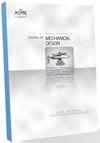大范围旋转平移兼容传动机构
IF 3
3区 工程技术
Q2 ENGINEERING, MECHANICAL
引用次数: 0
摘要
介绍了一种大范围运动柔性传动机构,该机构利用多自由度柔性模块的螺旋自由度(DOF)夹在另外两个单自由度柔性模块之间,将旋转输入转换为共线平移输出,反之亦然。当从旋转驱动到平移或从平移驱动到旋转时,该机构的几何优势(即传动比)可以根据需要进行调整。使用自由和约束拓扑(FACT)方法来设计机构,并使用刚度矩阵来解释为什么机构的传动比取决于机构是由其旋转还是平移输入驱动。制作了该机构的一个版本,测量了旋转驱动时的传动比为~1.36 mm/°,平移驱动时的传动比为~1.89 mm/°。传动比在机构的整个运动范围内都保持令人印象深刻的恒定,只有在不同方向上驱动时才略有变化(即,如果机构由旋转驱动,则为逆时针或顺时针,如果机构由平移驱动,则为推或拉)。本文章由计算机程序翻译,如有差异,请以英文原文为准。
Large-range Rotation-to-translation Compliant Transmission Mechanism
A large-range-of-motion compliant transmission mechanism is introduced that uses the screw degree-of-freedom (DOF) of a multi-DOF compliant module, sandwiched between two other single-DOF compliant modules, to convert a rotational input to a collinear translational output and vice versa. The geometric advantages (i.e., transmission ratios) of the mechanism when driven with a rotation to a translation or with a translation to a rotation can be tuned as desired. The freedom and constraint topologies (FACT) approach is used to design the mechanism, and stiffness matrices are used to explain why the transmission ratio of the mechanism is different depending on whether the mechanism is driven with its rotational or translational inputs. A version of the mechanism is fabricated and its transmission ratio is measured to be ~1.36 mm/° when the mechanism is driven with a rotation, and is measured to be the inverse of ~1.89 mm/° when the mechanism is driven with a translation. The transmission ratios both remain impressively constant over the mechanism's full range of motion and only vary slightly when they are actuated in different directions (i.e., counterclockwise or clockwise if the mechanism is driven with a rotation, or pushing or pulling if the mechanism is driven with a translation).
求助全文
通过发布文献求助,成功后即可免费获取论文全文。
去求助
来源期刊

Journal of Mechanical Design
工程技术-工程:机械
CiteScore
8.00
自引率
18.20%
发文量
139
审稿时长
3.9 months
期刊介绍:
The Journal of Mechanical Design (JMD) serves the broad design community as the venue for scholarly, archival research in all aspects of the design activity with emphasis on design synthesis. JMD has traditionally served the ASME Design Engineering Division and its technical committees, but it welcomes contributions from all areas of design with emphasis on synthesis. JMD communicates original contributions, primarily in the form of research articles of considerable depth, but also technical briefs, design innovation papers, book reviews, and editorials.
Scope: The Journal of Mechanical Design (JMD) serves the broad design community as the venue for scholarly, archival research in all aspects of the design activity with emphasis on design synthesis. JMD has traditionally served the ASME Design Engineering Division and its technical committees, but it welcomes contributions from all areas of design with emphasis on synthesis. JMD communicates original contributions, primarily in the form of research articles of considerable depth, but also technical briefs, design innovation papers, book reviews, and editorials.
 求助内容:
求助内容: 应助结果提醒方式:
应助结果提醒方式:


